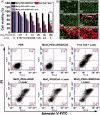Synergistic photothermal/photodynamic suppression of prostatic carcinoma by targeted biodegradable MnO2 nanosheets
- PMID: 31257941
- PMCID: PMC6610525
- DOI: 10.1080/10717544.2019.1631409
Synergistic photothermal/photodynamic suppression of prostatic carcinoma by targeted biodegradable MnO2 nanosheets
Abstract
The biodegradability and clearance of metal-based nanomaterials have been questioned worldwide, which have greatly limited their clinical translation. Herein, ultrathin manganese dioxide (MnO2) nanosheets with broad near-infrared (NIR) absorption and pH-dependent degradation properties were prepared. After being modified with polyethylene glycol-cyclic arginine-glycineaspartic acid tripeptide (PEG-cRGD), the MnO2 nanosheets were then used as photothermal agent and nanocarrier to encapsulate chlorin e6 (Ce6) for targeted photothermal (PTT) and photodynamic (PDT) of cancer. As expected, the MnO2-PEG-cRGD nanosheets show high Ce6 loading capacity (351 mg/g), superb photothermal conversion performance (37.2%) and excellent colloidal stability. These nanosheets also exhibit pH-dependent and NIR-induced Ce6 release. Furthermore, the MnO2 nanosheets can be degraded by reacting with hydrogen peroxide in the acidic microenvironment, which are able to elevate the oxygen concentration in situ and thus reverses the tumor hypoxia. Thanks to these favorable properties and the cRGD-mediated tumor-targeted ability, the fabricated MnO2-PEG-cRGD/Ce6 nanocomposites can be effectively up taken by alpha-v beta-3 (αvβ3) integrin over-expressed prostatic carcinoma PC3 cells and achieve favorable therapeutic outcomes under a single 660 nm NIR laser, which is also verified by in vitro studies. The biodegradable MnO2-PEG-cRGD/Ce6 nanosheets developed in this work can be a promising nanoplatform for synergetic PTT/PDT cancer therapy.
Keywords: Ce6; MnO nanosheet; photodynamic therapy; photothermal therapy; targeted delivery.
Figures






References
-
- Bray F, Ferlay J, Siegel RL, et al. (2018). Global cancer statistics 2018: GLOBOCAN estimates of incidence and mortality worldwide for 36 cancers in 185 countries. CA Cancer J Clin 68:394–424. - PubMed
-
- Chen Q, Feng L, Liu J, et al. (2016a). Intelligent albumin-MnO2 nanoparticles as pH-/H2O2-responsive dissociable nanocarriers to modulate tumor hypoxia for effective combination therapy. Adv Mater 28:7129–36. - PubMed
-
- Chen L, Feng Y, Zhou X, et al. (2017a). One-pot synthesis of MoS2 nanoflakes with desirable degradability for photothermal cancer therapy. ACS Appl Mater Interfaces 9:17347–58. - PubMed
-
- Chen J, Meng H, Yang R, et al. (2019). Recent advances in functionalized MnO2 nanosheets for biosensing and biomedicine applications. Nanoscale Horiz 4:321–38. - PubMed
-
- Chen W, Ouyang J, Liu H, et al. (2017b). Black phosphorus nanosheet-based drug delivery system for synergistic photodynamic/photothermal/chemotherapy of cancer. Adv Mater 29:1603864. - PubMed
MeSH terms
Substances
LinkOut - more resources
Full Text Sources
Other Literature Sources
Medical
Research Materials
Miscellaneous
